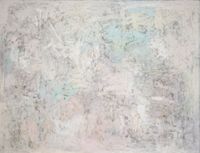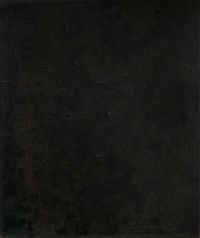Painter Ben Isquith created luminous colour field abstractions during his short time in the art world, adapting the energy of the New York School into nuanced compositions. As a member of the Tanager Gallery, Isquith enjoyed the camaraderie and support of a richly diverse and deeply dedicated artistic community. He regularly exhibited in solo and group shows beginning in the early 1950s, until his decision to leave the art world altogether less than a decade later.
Read MoreFounded in 1952 as an artists' collaborative, the Tanager Gallery was one of a network of artist-run galleries established on and around Tenth Street in the 1950s. These spaces fostered the careers of the young artists who made up the second generation of the New York School, providing exhibition space as well support for the atmosphere of artistic innovation that ruled the day. Tanager members included Alex Katz, Lester Johnson, Philip Pear!stein. Sidney Geist, Lois Dodd, William King and Tom Wesselmann, among others. Lending heft to their endeavours were the reigning Tenth Street champions Franz Kline and Willem de Kooning, whose studios were nearby and who often participated in Tanager group shows.
Ben Isquith was born in Brooklyn in 1928 and displayed an intense curiosity about the world around him from an early age. He funnelled this inquisitive energy into his art, first at Brooklyn College and then at the Yale University School of Art. Returning to New York from New Haven in the early 1950s, Isquith found an aesthetic home in the New York School. He counted among his friends de Kooning, Pearlstein, Philip Guston, and Milton Resnick, and participated enthusiastically in Tanager Gallery activities. The New York School's venerated chronicler, Irving Sandler, named Isquith as the first Colour Field painter and even owned a canvas.
Isquith worked in rich impastoes, delighting always in colour and surface. He received his first solo exhibition in 1951, at the Creative Gallery on 57th Street. The exhibition consisted of thickly painted canvases that explored subtle tonal variations. His most successful works found rhythm and order within these fields of colour, as he pushed into pure Colour Field painting before the movement had been named. Isquith's rhythmic structure is found in Pink Painting. The predominant pinks in this painting are offset by rusty orange and an eerie absinthe green. Isquith creates a glowing field of colour, but leaves apparent his process in the form of slashing and sweeping brushstrokes.
This same technique appears in Ivory Painting, a luminescent landscape of white, soft grey, and icy blue. Colour and form rise to the surface as if seen through a blinding snowfall, barely glimpsed before falling away again. Isquith's short, precise brushstrokes lend a vibrating kinetic energy that amplifies this sense. There is a kind of mystery inherent in these paintings, a spiritual weight perhaps inherited from the elder Abstract Expressionists. Ever a painter's painter, the care taken in these paintings has led some to describe them as studies of colour abstracted from great paintings of the past, ascribing the artist's motivation to "a love of beautiful passages of painting such as he finds in a Tiepolo sky or and area of drapery by Rembrandt." (1)
Isquith's generous use of paint introduced a literal dimensionality to his works as well as a metaphorical one. Deep ridges in the impasto lead to a play of light and shadow that morphs and develops as the viewer moves in front of the painting. This is perhaps most clear in Black Painting, a leathery surface of rich black whose accumulations of paint provide the scaffolding of the composition. By sticking with a single colour, here Isquith pushes the envelope of Abstract Expressionism and invites a careful consideration of both surface and material. Close looking reveals a full stable of application techniques, from wide, wet strokes to short gouging marks.
Although Isquith was a member of a robust community of artists and had received some amount of success in his time, he decided to leave the art world for good in the late 1950s. He dispersed his paintings to friends and colleagues and became a cyberneticist and mathematician in Washington, D.C. He died in 1968, just before his 40th birthday.
Courtesy Hollis Taggart





